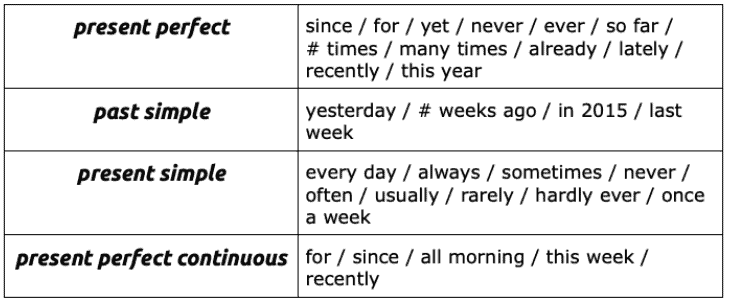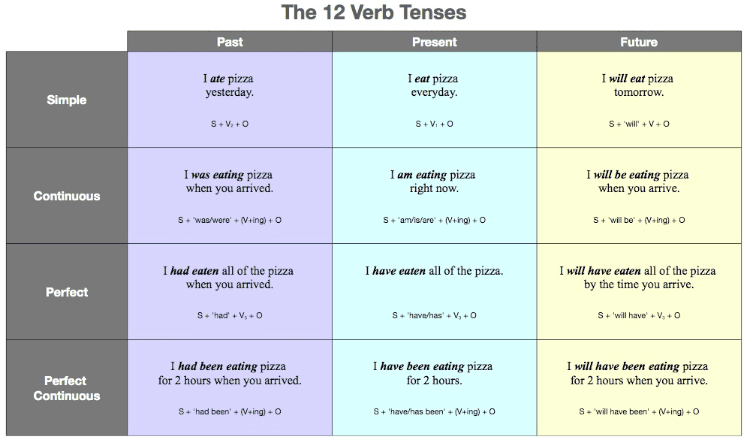How to Choose the Correct Tense when Speaking English
The web is full of generic blog posts advising English language learners how to choose the right tense when writing. However, this post offers some innovative techniques regarding how to choose the correct tense when speaking English. You got it. Tips to retrieve the right tense when you only have a split second.
Don’t learn all the tenses under the sun
I once wrote a piece urging English language learners to strip down the grammatical syllabus and focus only on those tenses which proficient users of English tend to use in conversation.
So, don’t fret when you come across those ghastly summaries or tables which show that there are 12 tenses:
I’ve also seen summaries claiming that English has 24 tenses (12 active forms and 12 passive forms). It’s worrying.
It becomes a whole lot easier to choose the correct tense when speaking English if you focus on the tense aspects which are most common in spoken English.
In my view, you should compartmentalise the following four tense aspects in your mind so that they’re ready to be retrieved when you speak English:
- Present perfect simple
- Past simple
- Present simple
- Present perfect continuous
Mastering these four aspects will help you handle typical getting-to-know-you conversations, as well as describe life experiences and speak about your career to date.
Another group of tense aspects to call upon in specific situations
You can also compartmentalise another group of tense aspects in your mind which you can call upon in specific situations. These tenses are:
- Past continuous
- Present continuous
- Future simple
- Past perfect
Mentally storing this second group of tenses aspects is purely optional. I respect that the present continuous is required to bring up temporary events that are happening around the time of speaking. However, I’ve written quite extensively about the dangers of teachers overexposing students to both the present simple and present continuous tenses at the same time or successively according to the grammatical syllabus.
Many of my Polish learners of English have a habit of overusing the present continuous tense. In an ideal world, teachers should avoid the teaching of the present continuous until a student has fully internalised the present simple, i.e. after many years of study and exposure. However, this is practically impossible when they have to 'teach to the test'.
As for the past continuous, it’s common to use it at the beginning of a story which has an unexpected twist:
Yesterday, as I was driving to work, …
The past continuous also shows that something continued over a longer period of time:
Everyone was dancing, just having a good time really.
Regarding will, it’s useful for making future predictions and decisions at the moment of speaking (including sudden requests, promises and offers):
I think the Republicans will win the next election (prediction).
Don’t worry - I’ll help you with your homework (a decision at the moment of speaking - a promise).
Feasibly, I could have included the future simple in Group 1 because it’s certainly on a par with the present perfect continuous in terms of how often it crops up in conversation between native speakers.
As for all the other tense aspects you’ve encountered in your English classes and in grammar workbooks, they’re rarely used in spoken English. Frankly, I can’t remember the last time I used the future perfect, future continuous and future perfect continuous tense aspects.
Techniques to use the correct tense when speaking English
It might seem like a tall order to be able to automatically choose the correct tense when speaking English. When you’re in full conversational flow, the last thing on your mind is probably English tenses. However, I believe there are several ‘tricks’ you can deploy to select the correct tense when speaking.
1. Focus on compartmentalisation
Earlier on, I wrote about storing four key tense aspects in your mind. I’d like to refer to this process as the compartmentalisation of tenses. Let me explain.
A typical dictionary definition of compartmentalise is:
to separate something into parts and not allow those parts to mix together.
Visualise the human brain and four shelves on one side of the brain. Imagine that the present perfect, past simple, present simple and present perfect continuous are lying to one side of the brain on their own individual shelves.
On the other side of each shelf, we now need to add a few words to summarise the key uses of the tenses. Here are the shelves, with the tenses and keywords summarising the uses of the tenses:

Just to explain the keywords then:
Present perfect
1. Unfinished action (since/for/today) - We use the present perfect when we want to talk about unfinished actions or states or habits which commenced in the past and continue up to the present time. The words 'since' or 'for' often feature heavily. When the period of time is still continuing, plenty of other time words and phrases come into play, such as today, this week, this month and this year:
I've known David since 1994
I’ve lived in Poland for five years
I've visitied five countries so far this year
2. Introduce life experiences - For events and actions which occurred during a person’s life. In contrast to the past simple tense, we don’t say when the experience occurred:
I’ve been to Berlin quite a few times
Believe it or not, I’ve never been skiing
3. A finished action with a result in the present - We often use the present perfect to talk about something that happened in the recent past. This finished action may still be true, or the result of the action or event may still be felt in the present time:
I’ve lost my wallet = I’m desperately searching for it
John’s hurt his back = It still hurts
I’ve missed my flight (the results of this event are far-reaching - not to mention the emotional impact and the need to reorganise one’s plans in the near future)
Past simple
1. Finished action (yesterday, last month, in 2019) - Finished actions with a finished time reference:
The first time I visited Poland was in 2005
2. ‘Details of news’ - Although you may have introduced a life experience or action with the present perfect simple tense, any details that follow should be in the past simple:
I’ve been on holiday. I went to Spain for a few weeks
Present simple
1. More or less permanent situations - We use the present simple tense to describe situations that are expected to last (i.e. situations that or more or less permanent):
I can’t stand hip-hop music
Jenny works in a bank
2. Regular actions and habits - With the help of adverbs of frequency (such as ‘usually’, ‘often’ and ‘sometimes’), as well as expressions such as ‘twice a week’ or ‘every day’, the present simple describes habits and activities we do on a regular basis:
I go to music school every day
I sometimes drink coffee
Do you smoke?
Present perfect continuous
1. Unfinished actions - past, present and future - Used to describe unfinished actions which commenced in the past, continue to the present and are expected to continue into the future. Often in response to questions beginning ‘How long …’, we often use for and since:
How long have you been learning Polish?
I’ve been waiting for John to come home for hours
I’ve been living in Łódź for six months
2. Temporary habits or situations - The action began in the past and continues to the present. Unlike the first use, there’s no emphasis on ‘how long’ a situation or habit lasts. Instead, we use words like lately and recently:
I’ve been listening to a lot of jazz music lately
David’s been living with his dad while he searches for a flat
3. Actions that have recently stopped - Actions that have recently stopped and have an obvious result in the present. In other words, we can often feel, hear or see this result. It’s also important to mention that the action might be unfinished:
I’ve been working out - I'm exhausted
I’ve been running - I'm so hot and sweaty
As already mentioned, visualisation is key when it comes to compartmentalisation and the two sets of shelves. If you want to choose the correct tense when speaking English, you need to visualise these shelves and their contents.
Of course, the right side of each shelf could contain a lot more keywords and information pertaining to the rules of a certain tense. However, the idea of compartmentalisation is to prioritise.
2. Create a mental connection with time markers
In a similar vein to the compartmentalisation and keywords which summarise the main uses of tenses in 1 above, it’s a good idea to consider time markers that are generally used with specific tenses.
Once again, compartmentalisation is the name of the game. So, let’s move to the other side of the brain. The aim is to visualise another set of shelves with the four tenses on one side, and their associated time markers on the other:

As you may have noticed, I haven’t added all of the possible variations of each time marker. For instance, with the past simple tense, last week should be enough of a trigger for you to produce 'last month' and 'last year' etc. Overall, minimise and prioritise as much as possible with the information on your ‘shelves’.
Of course, memorisation comes into play. However, don’t forget that you’ll need to fall back on visualisation when you need to retrieve a tense when in full conversational flow. If it helps, use colours, bold font and italics to create the ideal conditions for visualisation/memory retrieval to occur.
When you’re speaking English, and have just a split second to think and formulate a sentence in your mind, let these time markers trigger the tense you need to use.
It’s very handy that time expressions associated with the past simple can go before the main verb (went):
… So, last week, I went down to Brighton for the first time in years
Hence, the time marker 'last week' should do nothing else but be the trigger for ‘I went …’.
It’s a similar case with the adverbs of frequency connected with the present simple:
I often help my dad clear up his garden when it’s overgrown
Hence, as soon as you utter a word like often, you literally have a fraction of a second to visualise the shelves and retrieve the present simple form of the verb (help).
Admittedly, things become a little more complicated with time markers that must go after the main verb. This is the case for many time expressions associated with the present perfect, for example, many times and yet. In such cases, I believe that advice point number 4 below will help you.
3. Numbers matter
In my first class with new students, I very often introduce two of the big guns in tandem - the present perfect and past simple. The purpose of the class is to get students talking about their life experiences. These life experiences should be introduced in the present perfect tense. The role of the past simple is to fill in all the precise details about the experience.
For example:
I’ve been to Berlin quite a few times (present perfect)
The first time I went there was on a school trip. I was 14 years old
We travelled to Berlin all the way from my home town in central England by coach
The last time I visited Berlin was back in 2013. I went with a friend from Łódź
When it comes to choosing the correct tense when speaking about life experiences, I encourage my students to think in terms of a number pattern - 1, 2, 2, 2.
Hence, you could assign the number 1 to the present perfect tense because it introduces a life experience. The number 2 represents all the details in the past simple tense.
The 1-2-2-2 pattern is not difficult to recall or visualise in any way. Make sure you are ‘in touch’ with it when you’re speaking about life experiences. If you find you’re mixing up the two tenses, 1-2-2-2 will help you ‘reset’.
There’s nothing wrong with tagging on and memorising keywords to help you ‘reset’:
1 - introduce / how many times
2 - details / finished
Are there any other combinations of tenses which encourage the adoption of a number pattern to help one retrieve the right tense when in full conversational flow?
Off the top of my head, you could apply the same 1-2-2-2 pattern when telling a story using both the past continuous and past simple tenses.
One use of the past continuous is to provide the background of a story. To set the scene, so to speak. After providing the context for the story, switch to the past simple to describe the main events:
1 - past continuous
2 - past simple
2 - past simple
2 - past simple
Example:
I was hanging out the washing on the line yesterday when I heard this massive bang. I quickly ran around to the front of the house when, believe it or not, I saw a small Fiat upside down on the bend…
All in all, basic number patterns such as 1-2-2-2 can help you to organise your storytelling and choose the correct tense when speaking English.
4. Personalisation and familiarisation
When I picked up the Serbian language back in 2013, I mostly relied on updating a Word-Phrase Table. On one side of the column, I added Serbian words and phrases which I came across on an everyday basis. In the right hand column, I added true sentences about myself, life experiences and opinions about anything and everything. Of course, all of these sentences contained the target word or phrase.
I regularly read through all of these personalised sentences and found that they were floating around my mind while I was speaking Serbian. In my view, the very essence of fluency is being able to automatically retrieve whole sentences, or even phrases and collocations these sentences consist of, when speaking a second language.
Moving on to choosing the correct tense when speaking English, I think there’s a lot to be said for writing personalised sentences for some of the tenses I’ve already written about in this post.
Ten sentences is not enough. In order to become familiar with a tense, strive to write at least 25 sentences. Let me start you off with the present perfect based on my own life experiences:
I’ve been to Berlin four or five times
I’ve never been skiing
I’ve been to the Crucible Theatre in Sheffield once to see the World Snooker Championship
Final Thoughts on Selecting the Correct Tense when Speaking English
I have described above some handy tricks to help you choose the correct tense when speaking English.
These tricks are major pieces of a very large puzzle. You still need to listen and read a lot to enable tenses and their associated time markers to subconsciously ‘sink in’.
My final message is - don’t underestimate the personalisation side of language acquisition. Read through point 4 above again.




